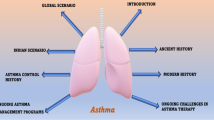Abstract
Asthma is one of the oldest diseases about which there are lots of myths in most parts of the world. The exact cause of this global disease still eludes scientists. The recent knowledge about the pathogenesis of the disease, led to rationalise the medications into different groups. Parallel to the increasing incidence of this disease, is the knowledge about the trigger factors and steps to reduce their exposure. Childhood asthma is a lot different from asthma in adults, as many children won’t be able to use the inhalers like adults and most children will not be able to do lung function tests until they are about 6 years of age. Unlike for any other diseases, research has helped year after year in developing new strategies for management of asthma. Starting from definition of the disease to inventing newer medications, management of asthma has revolutionised in the last few years and has also accounted for the decreasing mortality in many countries. This article tries to give an overview of bronchial asthma in children including recent advances and possible future developments.
Similar content being viewed by others
References
The International Study of Asthma and Allergies in Childhood (ISAAC) Steering Committee. World-wide variation in prevalence of symptoms of asthma, allergic rhinoconjunctivitis, and atopic eczema; ISAAC.Lancet 1998; 351: 1225–1232.
National Asthma Campaign, Australia.Asthma Management Handbook, 1996.
Silverman, Wilson N. Asthma-time for a change of name?Arch Dis Child 1997; 77: 62–65.
Harrison BDW. Guidelines in asthma.Resp Med 1996; 90 375–378.
Warner JO. Asthma: a follow up statement from an international paediatric asthma consensus group.Arch Dis Child 1992; 67: 240–248.
Wildhaber JH, Devadason SG, Eber E,et al. Effect of electrostatic charge, flow, delay and multiple actuations on the in vitro delivery of salbutamol from different small volume spacers for infants.Thorax 1996; 51 985–98.
Keeley D, Rees J. New guidelines on asthma management.BMJ 1997; 314: 315–16.
Ladebauche P. Managing asthma: a growth and development approach.Pediatr Nursing 1997; 23 (1): 37–44.
Howell JH, Flaim T, Lung CL. Patient education.Pediatr Clin N Amer 1992; 39 (6): 1343–1360.
Agercrof L, Pedersen S. Influence of spacer device on drug delivery to young childern with asthma.Arch Dis Child 1994; 71: 217–220.
Lenney W, Price J, Warner JOet al. Guidelines for the management of asthma in adults and children.Thorax 1993; 48: Supplement S1-S24.
British Thoracic Society. British Guidelines on Asthma management 1995. Review and Position statement.Thorax 1997; 52 (Supp 1): S1-S21.
Kon OM, Barnes N. Immunosuppressive treatment in asthma.Br J Hosp Med 1997; 57 (8): 383–386.
Samuelsson B. Leukotrienes: mediators of immediate hypersensitivity reactions and inflammation.Science 1983; 220: 568–575.
Chanarin N, Johnston SL. Leukotrienes as a target in asthma therapy.Drugs 1994; 47: 12–24.
Sampson AP, Castling DP, Green CP, Price JF. Persistent increase in plasma and urinary leukotrienes after acute asthma.Arch Dis Child 1995; 73: 221–225.
Virchow JC, Nolle PS, Wiessman KJet al. Multicenter trial of Bay × 1005, a new 5-lipoxygenase activating protein inhibitor in the treatment of chronic asthma.Am J Respir Crit Care Med 1995; 151: 377.
Hui KP, Barnes NC. Lung function improvement in asthma with a cysteinyl leukotriene antagonist.Lancet 1991; 337: 1062–1063.
Hall IP. The future of asthma.BMJ 1997; 314: 45–49.
Author information
Authors and Affiliations
Corresponding author
Rights and permissions
About this article
Cite this article
Kumar, R.K. bronchial asthma: Recent advances. Indian J Pediatr 67, 293–298 (2000). https://doi.org/10.1007/BF02758176
Issue Date:
DOI: https://doi.org/10.1007/BF02758176




